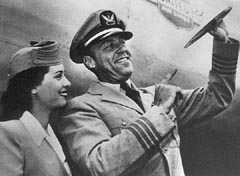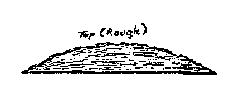United Airlines
Flight 105 Case
Emmett, Idaho
July 4, 1947

Stewardess Marty Morrow & Captain E. J.
Smith,
courtesy of Wendy Connors
Wendy Connors & Michael Hall:
Two other independent sets of observers in other parts of Seattle
reported seeing multiple discs about a half an hour before Ryman took
his photos.
That night an incident occurred which was second only to
Arnold's sighting in terms of media coverage. Captain E.J. Smith and
First Officer Ralph Stevens of United Airlines Flight 105 were the
chief witnesses. Shortly after takeoff from Boise's Cowan Field at 9:04
P.M. MST, they observed from their DC-3 airliner five discs
"silhouetted against the sunset in a loose formation." When Smith asked
Stewardess Marty Morrow to come forward, she confirmed the observation.
Ironically, before the crew boarded the plane, someone had asked them
if they had seen any flying saucers - as the disc sightings were by
then starting to receive more and more publicity. Smith snapped back
with a smile that, "I'll believe them when I see them."
In that dark cockpit Smith remembered his famous last words as
they watched the mysterious sight for several minutes as four more
discs joined the group just as the original five faded from sight. The
second group flew in a straight line formation of three together with
the fourth one off by itself. Smith said "this group seemed to be
higher than our flight path," [then at 7,000 feet] "and when they did
leave, they left fast!"
The sightings lasted twelve minutes and covered 45 miles as
the unknown objects moved in a northwesterly direction across Idaho. At
one point Smith recalled that it looked almost as if some of the discs
merged together. Reaching a cruising altitude of 8,000 feet, Smith had
attempted to close in for a better look as the discs neared Oregon but
could not attain an airspeed much above 185 miles per hour. At that
point he contacted the nearest observer he could reach - the radio
tower at Ontario, Oregon. The attendant there could not see anything,
yet neither could the pilots by that point. The objects had suddenly
sped out of the area at tremendous speed. (25)

This sketch depicts the only details the crew could
definitely give to Intelligence officers - thin oval craft "smooth on
the bottom and rough on top." Smith told the International News Service
that the mysterious objects "were as big as an airplane but definitely
were not aircraft." This sighting ended up in Air Force files as the
third of nine in 1947 records to receive the sparingly-given
designation "unidentified." Known as the United Airlines Flight 105
Case, it was second in fame only to the Kenneth Arnold Sighting during
1947. This would be only the first of four cases involving United
Airlines flights over the following six weeks.
|
The news media was already waiting at Pendleton for a
scheduled landing of the plane because many people had overheard the
radio transmissions back and forth between Ontario tower and Flight
105. As a result, the story became an immediate sensation. Both Naval
Intelligence and Brown and Davidson from Army Intelligence interviewed
Captain Smith.
The Brown and Davidson interview occurred on July 12th just
after they had finished talking with Kenneth Arnold at the Hotel Owyhee
about his incident. Arnold then invited them to his home for coffee and
sherbet. While at Arnold's house they heard Smith was in Boise for a
layover, so they all went out to the airport to talk to Smith and were
joined by Dave Johnson from the Boise Evening Statesman.
Alfred Loedding probably would not have had the fine details
of the interview via the Fourth Air Force until several months later.
Coordination until at least September of 1947 was very haphazard, not
only between the 4th AAF but with Dayton and Washington. Yet, because
he was a Pentagon liaison, Loedding probably knew more at any one given
time that summer than any single group doing investigations. Edward
Ruppelt later wrote about those days:
| At first there was no coordinated effort to collect
data on the UFO reports. Leads would come from radio reports or
newspaper items. Military intelligence agencies outside of ATIC
[Dayton] were hesitant to investigate on their own initiative because,
as is so typical of the military, they lacked specific orders.
When no orders were forthcoming, they took this to mean
that the military had no interest in UFO's. But before long this placid
attitude changed, and drastically. Classified orders came down to
investigate all UFO sightings. Get every detail and send it directly to
Wright Field. The order carried no explanation as to why the
information was wanted.
This lack of an explanation and the fact the information
was to be sent directly to a high-powered intelligence group within Air
Force Headquarters stirred the imagination of every potential
cloak-and-dagger man in the military intelligence system. Intelligence
people in the field who had previously been free with opinions now
clammed up tight.
|
On that same night the manager of the Idaho United Press
and a fifteen year veteran reporter, John C. Corlett,
had a sighting that seemed to confirm the presence of something strange
near Flight 105.
While relaxing at home in his garden, he and his wife with
their dinner guests, famed Boise artist V.H. Selby and his wife, all
had a disc sighting. It occurred around the same time as Captain
Smith's encounter when the couples observed a white disc zoom across
the sky in a matter of just seconds. The object came from the northwest
and traveled southeast as it passed silently overhead at an altitude of
about 10,000 feet in a clear sky.
Earlier that afternoon in Idaho, disc activity had been
observed near the Twin Falls area. Between 2:30 P.M. MST
and 3:10 PM. three groups of discs ranging from twenty to nine objects
were seen by over sixty persons enjoying the 4th of July celebrations
in the local park of Twin Falls.
Source: Alfred Loedding and The Great FIying Saucer Wave of
1947, Wendy Connors and Michael Hall, pages 52-55.
25 Project Blue Book Files, Roll No.1, Case 34,
listed as Incident 10 in 1947 era documents; and The NewYork Times,
6 July 1947, pp. 1,36.
|